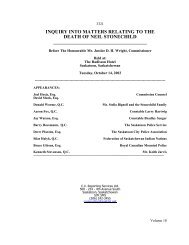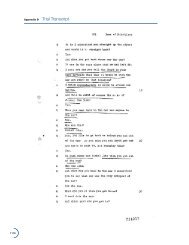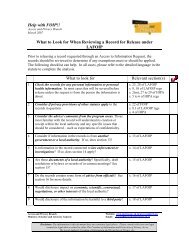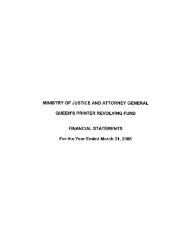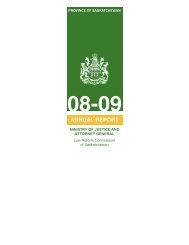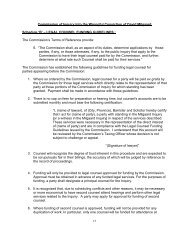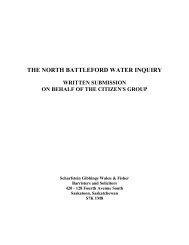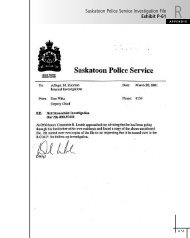Appendix K Memorandum of Law - s. 9(2) of the Canada Evidence Act
Appendix K Memorandum of Law - s. 9(2) of the Canada Evidence Act
Appendix K Memorandum of Law - s. 9(2) of the Canada Evidence Act
You also want an ePaper? Increase the reach of your titles
YUMPU automatically turns print PDFs into web optimized ePapers that Google loves.
<strong>Appendix</strong> K <strong>Memorandum</strong> <strong>of</strong> <strong>Law</strong><br />
Third Branch: Alternatively, if, in <strong>the</strong> opinion <strong>of</strong> <strong>the</strong> court, <strong>the</strong> witness proves adverse, <strong>the</strong> party<br />
producing <strong>the</strong> witness may, with leave <strong>of</strong> <strong>the</strong> court, prove that <strong>the</strong> witness made, at o<strong>the</strong>r times, a<br />
statement inconsistent with his present testimony. However, before <strong>the</strong> party producing <strong>the</strong> witness<br />
can prove <strong>the</strong> inconsistent statement, <strong>the</strong> party must:<br />
(i)<br />
(ii)<br />
mention to <strong>the</strong> witness <strong>the</strong> circumstances <strong>of</strong> <strong>the</strong> supposed statement (sufficient to designate <strong>the</strong><br />
particular occasion); and<br />
ask <strong>the</strong> witness whe<strong>the</strong>r he or she made <strong>the</strong> supposed statement.<br />
Section 9(2) <strong>of</strong> <strong>the</strong> CEA came into force on February 13, 1969 and read as follows at that time:<br />
9(2) Where <strong>the</strong> party producing a witness alleges that <strong>the</strong> witness made at o<strong>the</strong>r times a statement in writing,<br />
reduced to writing, inconsistent with his present testimony, <strong>the</strong> court may, without pro<strong>of</strong> that <strong>the</strong> witness is<br />
adverse, grant leave to that party to cross-examine <strong>the</strong> witness as to <strong>the</strong> statement and <strong>the</strong> court may consider<br />
<strong>the</strong> cross-examination in determining whe<strong>the</strong>r in <strong>the</strong> opinion <strong>of</strong> <strong>the</strong> court <strong>the</strong> witness’ is adverse.<br />
The foregoing version <strong>of</strong> s. 9(2) <strong>of</strong> <strong>the</strong> CEA was in force during David Milgaard’s trial in 1970.<br />
(2) Principles <strong>of</strong> Statutory Construction and Interpretation<br />
Driedger on <strong>the</strong> Construction <strong>of</strong> Statutes sets out <strong>the</strong> following principles with respect to ascertaining <strong>the</strong><br />
purpose <strong>of</strong> legislation (‘reform legislation’ in particular):<br />
Historically, purposive analysis is associated with <strong>the</strong> so-called mischief rule or <strong>the</strong> rule in Heydon’s Case.<br />
Although this rule did not originate in Heydon’s Case, it was <strong>the</strong>re it received it’s most famous and influential<br />
formulation:<br />
For <strong>the</strong> sure and true interpretation <strong>of</strong> all statutes in general (be <strong>the</strong>y penal or beneficial, restrictive or<br />
enlarging <strong>of</strong> <strong>the</strong> common law) four things are to be discerned and considered: –<br />
1st. What was <strong>the</strong> common law before making <strong>the</strong> <strong>Act</strong>.<br />
2nd. What was <strong>the</strong> mischief and defect for which <strong>the</strong> common law did not provide.<br />
3rd. What remedy <strong>the</strong> Parliament hath resolved and appointed to cure <strong>the</strong> disease <strong>of</strong> <strong>the</strong><br />
commonwealth.<br />
And<br />
4th. The true reason <strong>of</strong> <strong>the</strong> remedy; and <strong>the</strong>n <strong>the</strong> <strong>of</strong>fice <strong>of</strong> all Judges is always to make such<br />
construction as shall suppress <strong>the</strong> mischief, and advance <strong>the</strong> remedy, and to suppress subtle<br />
inventions and evasions for continuance <strong>of</strong> <strong>the</strong> mischief, and pro privato commodo, and to<br />
add force and life to <strong>the</strong> cure and remedy, according to <strong>the</strong> true intent <strong>of</strong> <strong>the</strong> makers <strong>of</strong> <strong>the</strong> <strong>Act</strong>,<br />
pro bono publico.<br />
Judges are here advised to not only interpret legislation to promote its purpose but also to suppress measures<br />
designed to avoid <strong>the</strong> impact <strong>of</strong> <strong>the</strong> legislation and add to <strong>the</strong> scheme, if necessary, to ensure that <strong>the</strong><br />
legislature’s true intent is accomplished.<br />
…<br />
Reform legislation is generally modest in its aspirations. It is meant to cure perceived defects or oversights in<br />
existing law by introducing new rules. The new rules are designed to supplement <strong>the</strong> existing regime in certain<br />
limited ways or, in <strong>the</strong> case <strong>of</strong> a more ambitious reform, to replace <strong>the</strong> existing regime with a full set <strong>of</strong> new<br />
rules. In ei<strong>the</strong>r case, however, <strong>the</strong> new rules are meant to operate within <strong>the</strong> established framework <strong>of</strong> existing<br />
private law. This is essentially a common law framework. Even though private law has come to include significant<br />
2576



